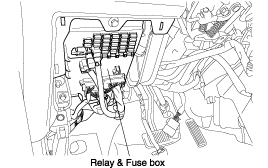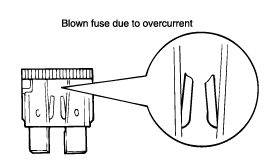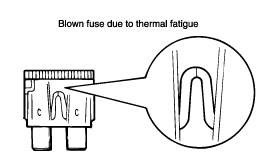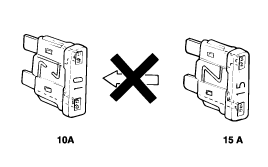There should be no continuity between the No.1 and No.2 terminals when power is disconnected.

There should be continuity between the No.1 and No.4 terminals when power and ground are connected to the No.3 and No.2 terminals.
There should be no continuity between the No.1 and No.4 terminals when power is disconnected.


There should be continuity between the No.1 and No.2 terminals when power and ground are connected to the No.3 and No.4 terminals.
There should be no continuity between the No.1 and No.2 terminals when power is disconnected.


Be sure there is no play in the fuse holders, and that the fuses are held securely.
Are the fuse capacities for each circuit correct?
Are there any blown fuses?
If a fuse is to be replaced, be sure to use a new fuse of the same capacity. Always determine why the fuse blew and completely eliminate the problem before installing a new fuse.
Never use a fuse of higher capacity than specified.

Fuse blown due to over-current.
Prior to replacing the fuse with a new one, check the circuit for a short and the related parts for abnormal conditions. Only after the correction of a short or replacement of abnormal parts, should a fuse with the same ampere rating be installed.

Fuse blown due to repeated on-off current.
Normally, this type of problem occurs after a fairly long period of use, and is less frequent than #1 above. In this case, you may simply replace with a new fuse of the same capacity.

A blade type fuse is identified by the numbered value in amperes. If the fuse is blown, be sure to replace a fuse with the same ampere rating.If a fuse of higher capacity than specified is used, parts may be damaged and a danger of fire exists. To remove or insert a fuse, use the fuse puller in the fuse box.
